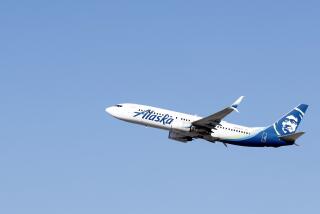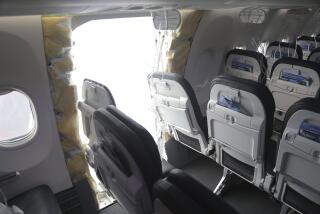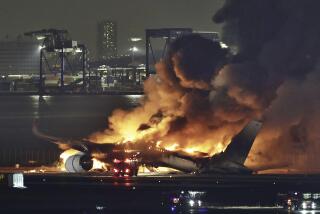FAA to Order Jet Insulation Replacement
WASHINGTON — The Federal Aviation Administration announced Wednesday plans to require U.S. airlines to replace the insulation on 699 jetliners over the next four years in hopes of preventing fires like the one that apparently led to a deadly crash off Nova Scotia last fall.
The FAA order is intended to prepare the airlines to meet new, stricter standards for aircraft insulation that the agency plans to issue within a few months. Those new standards would effectively prohibit the airlines from using metalized Mylar insulation.
The changes, which are expected to cost the airlines $300 million over four years, apply only to five kinds of aircraft--the MD-11, MD-80, MD-88, MD-90 and DC-10--all built in Long Beach by the former McDonnell Douglas Corp., which is now owned by Boeing Co.
The FAA action comes in the wake of the crash of a Swissair MD-11 near Peggy’s Cove, Canada, in September, 13 minutes after the airplane’s crew reported smoke in the cockpit. All 229 people on board the wide-bodied jetliner died.
Although FAA officials said that they have seen few incidents besides the Swissair crash in which the flammability of Mylar insulation had been a factor, they said that the material burns so rapidly that the problem should be addressed now.
FAA Slow to Act Over 1996 Warning
Both Boeing and the FAA said that McDonnell Douglas had warned the airlines about the problem in August 1996 and advised that the insulation be replaced. The danger of Mylar, an approved material when it was installed, was shown by subsequent tests.
However, the FAA, which also found the Mylar insulation to be unusually flammable during separate tests in 1997, did not move immediately to order the material removed. FAA officials conceded Wednesday that the danger became an urgent issue only after the Swissair crash.
The Swissair accident is still under investigation, but Canada’s Transportation Safety Board issued a report Wednesday that found the Mylar insulation had been “a significant source” of the combustible materials that kept the fire burning.
The FAA order, which would take effect after a 45-day period for public comment, fell short of a plan that the agency had discussed in October. That plan would have required the replacement of insulation in almost all commercial aircraft. But officials said recent tests had shown that non-Mylar insulation is sufficiently flame-retardant.
Elizabeth Erickson, the FAA’s director of aircraft certification, said that most other kinds of insulation now being used in commercial airliners come close enough to meeting the new standards to be considered acceptable and “do not pose a threat to aviation safety.”
She said that metalized Mylar insulation--a trade name for a synthetic known as polyethylene terphthalate, or PET--had been shown to be more “easily ignitable” than other materials and that it “does not pass the [FAA’s] new standards by a wide margin.”
The FAA said that its new order would apply to 699 U.S.-registered aircraft, owned by American Airlines, Delta Air Lines, Continental Airlines, Trans World Airlines, Alaska Airlines, Federal Express, Reno Air, Aeromexico and USAirways.
The agency said that the insulation problem also exists in 531 aircraft registered abroad. These jetliners are not directly subject to FAA regulation, but officials said that they frequently comply voluntarily with FAA orders because they often use U.S. airports.
Mylar, which typically is used to strengthen or protect other synthetic materials, is used to cover pillow-shaped wads of fiberglass placed in the ceiling areas of planes in front of and behind the cockpit wall and throughout passenger compartments.
In a telephone conference call with reporters, Erickson said that the FAA would ask airlines to survey their planes to decide first, whether they contain metalized Mylar insulation, and second, how accessible the material is for replacement.
The airlines then would be directed to remove the Mylar insulation and replace it as soon as practical--if possible, the next time the aircraft gets scheduled maintenance.
Each airline would do the work itself or contract it out.
The FAA estimates that the changes could cost the airlines between $380,000 and $880,000 for each airplane, depending on how much Mylar is involved and where it is located. Insulation in the passenger area is easier to reach than that in other areas.
Airline industry representatives reacted cautiously to the FAA announcement.
Diana Cronan, spokeswoman for the Air Transport Assn., which represents the nation’s large airlines, said that the industry is ready to cooperate in ensuring safety aboard commercial aircraft but expressed “concern” to the FAA about “moving prematurely.”
She said that the airlines are worried about two factors: No one has ever replaced Mylar insulation so extensively, and “we don’t yet have a clear picture of how it should be done.” The airlines also fear that the work could result in “inadvertent damage” to wiring.
Only a Few Other Incidents Cited
Boeing Co. spokesman Lori Gunter said her firm wholeheartedly supports the FAA’s efforts, which she said “will make mandatory [the] recommendation that we made to [airline] operators in 1996.”
Erickson said there had been only a handful of incidents besides the Swissair crash in which Mylar insulation had caught fire. The two most recent incidents involved cargo planes.
She said that the material itself “is not a safety threat” and that the danger exists “only when [the Mylar] is around a spark.” There have been suggestions that the fire aboard Swissair Flight 111 might have been caused by arcing in a wire.
Flight 111 had been en route from New York’s John F. Kennedy International Airport to Geneva when its cockpit crew apparently was overcome by smoke from an internal fire. Efforts by the pilot to make an emergency landing in Halifax failed.
More to Read
Inside the business of entertainment
The Wide Shot brings you news, analysis and insights on everything from streaming wars to production — and what it all means for the future.
You may occasionally receive promotional content from the Los Angeles Times.










